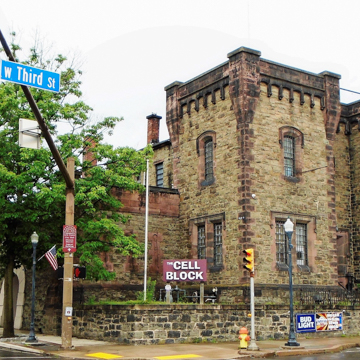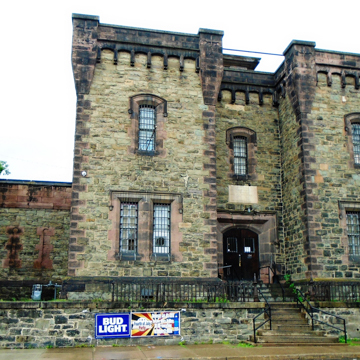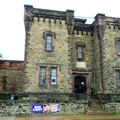You are here
Commercial Building (Lycoming County Jail)
Lycoming County's fortresslike former jail looks much like other Pennsylvania jails built after 1825. And well it should, for its architect was Edward Haviland, who trained as a lawyer but turned to architecture after 1853, working in York. Like his father, John Haviland (Eastern State Penitentiary; PH126), Edward specialized in prisons. This building replaced the jail of 1801 that was built on two of the four lots that Michael Ross donated to the county. After a fire in 1867, that jail was demolished, making way for this brownstone-trimmed rock-faced sandstone building. The sheriff's residence fronts 3rd Street with the brick and sandstone cells, enclosed by a battered stone wall, stretching out behind it. The jail is a mix of Gothic, Romanesque, and Georgian forms. Unfortunately, the tower that was centered over the sheriff's residence was removed, leaving only its awkwardly sloped and truncated base. The county closed the jail in January 1986 and moved prisoners to a new jail three blocks west on 3rd Street. The building was sold and for a time the cellblock was converted to artists’ shops; most recently it has been a nightclub. The jail originally served the county courthouse designed by Samuel Sloan (1860), since demolished and replaced by a bland modernist cube (1970, Wagner-Hartman Associates).
Writing Credits
If SAH Archipedia has been useful to you, please consider supporting it.
SAH Archipedia tells the story of the United States through its buildings, landscapes, and cities. This freely available resource empowers the public with authoritative knowledge that deepens their understanding and appreciation of the built environment. But the Society of Architectural Historians, which created SAH Archipedia with University of Virginia Press, needs your support to maintain the high-caliber research, writing, photography, cartography, editing, design, and programming that make SAH Archipedia a trusted online resource available to all who value the history of place, heritage tourism, and learning.









